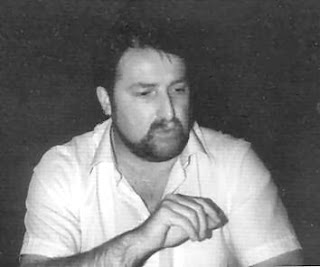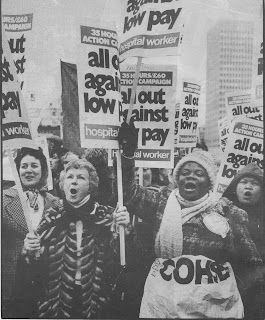
Bill Dunn COHSE (1927-1983)
Bill Dunn COHSE Hanwell Ambulanceman was born in Liverpool on 8th March 1927. he died of cancer on St Patrick’s Day 17th March 1983 at the age of 56.
Anyone who met Bill could not fail to admire his courage and fighting spirit. There were many occasions during his life when he needed a considerable amount of both. One of a family of six, he was orphaned by the age of three and spent his childhood in Dr Barnardo's Homes or with foster parents.
It was during the time that he lived in Dr Barnardo's that he first learned about socialism and the trade union movement from no less a person than one of Labour's first women MPs, Bessie Braddock, who was a regular visitor.
Bill joined the Royal Marines at the age of sixteen, under a special arrangement with Dr Barnardo's and saw active service in various parts of the world during his fourteen years' service. He enjoyed the comradeship but hated the system. He had a strong dislike for what he regarded as petty rules and regulations. In fact, while in the marines he was promoted to the rank of lance corporal no less than six times, but, as Bill put it, 'I got busted every time'.
Bill suffered further personal tragedies during the war when he lost one brother on active service and another in a submarine accident in Liverpool Bay.
After leaving the armed services, Bill worked for a time with the Shell Oil company, traveling all over the world. Then he worked in a number of jobs before joining the London Ambulance Service in 1968. Such was his energy that, on his leaving an agent job to work for a plant hire firm, three men were taken on in his place.
Bill met his wife, Maureen, in1964 They were married in 1966 and had two daughters, Alison, now sixteen, and Claire, now thirteen.
I first met Bill when he attended the No. 6 Regional Council meeting in October, 1975, as delegate for Park Royal Branch. Within a few months he had formed a branch of COHSE at Hanwell Ambulance Station, Ealing, London which went on to become one of the biggest branches in the region. Bill was elected Regional Vice-Chairman in 1978, and Regional Chairman one year later, in 1979, a position he held until his death.
He was totally committed to socialism and the trade union movement, and made it clear that as Regional Chairman he expected to be involved with branches' problems. He travelled all over the region, giving support to members who needed it.
He was also active in the CND movement and took a special interest in mentally handicapped children.
It was absolutely typical of Bill to fight his last fight with the same courage as he had fought all his life — his way, head on. He refused to hide or run away. He attended every rally organised in the region during the last pay campaign,
although obviously he was in considerable pain and had difficulty in breathing. I remember suggesting to Bill on one occasion that I should hire a taxi to take him to the rallying point rather than walk. I will not repeat exactly what his reply was, suffice to say my Regional Chairman left me in no doubt that he intended to walk.
It is easy to feel despondent about the loss of someone who was so strong and seemed so indestructible, but to give up the struggle for all the things Bill believed in is just unthinkable. Rest in peace, brother. Your fight goes on.
(Tribute by Pat McGinley,
COHSE No. 6 North West Thames & Oxford Regional Secretary.)
NOTE
Bill Dunn was one of the most important COHSE lay activist and showed great leadership especially, during the 1979 Ambulance Strike when his house and car were attacked by those opposed to the strike and he was also attacked by those on the ultra left, who condemned his insistence on “Emergency Cover” during the strike.
His support for nuclear disarmament at national COHSE conference was key in securing COHSE’s conference support
A Trophy the Mallinson – Dunn Trophy is awarded annual, since 1984, to an ambulance man or women for recognition of their work in COHSE now UNISON
A garden at the front of Hanwell Ambulance Station is dedicated to his memory
Note on COHSE Hanwell/Ealing branch
The Hanwell branch under Bill, included Ealing and Hillingdon Hospital at one time in the late 1970s. Hillingdon Hospital not reforming a branch until 1982 under Mike Lee a COHSE nursing Auxiliary (who later went onto the Football Association and European Football association fame) Then Michael Walker 1983-1991) and now Florence Portugal (1992-
Marion Way (NUPE Ambulance steward at Hillingdon, London Ambulance Service first women convenor and Labour Councillor, won the Mallinson-Dunn Trophy after it was adopted by UNISON)
Bill took the much photographed delegation from Ealing to TUC Conference in 1982 during the 12% campaign. Also spoke at LSE in 1982
COHSE London Ambulance Service branch (699) established November 1964
Branch Chairman Bert Conaway, 10 Silver Walk, Rotherhithe (ex docker for 15 years) Ted King (Secretary) 16 St Stephen's, Bow (ex bus driver) both worked at West Smithfield Ambulance Station (known as Whisky Station - from their radio call signal) since 1962.
First COHSE LAS branch meeting held at Hop Pole Pub, Gambia Street, S1 on 17th December 1964 (with 80 members)



































